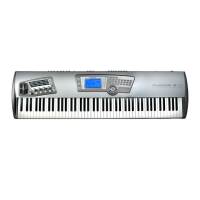ALESIS FUSION
ANALOG SYNTHESIS TUTORIAL
However, we can also apply an envelope to filter cutoff - in this way
we can vary a sound’s tone
over time during the course of a note. For example, you will remember
that when we looked at
harmonics, we discovered that in nature, high frequencies tend to have less energy and so
tend to die away quicker than low frequencies and indeed, if you have played a note on a
piano
or plucked a string on a guitar, you will have heard this - as the
sound dies away, it tends to get
softer in tone over
time. By applying an envelope to a lowpass filter, we can go some way to
replicating this phenomenon - when the envelope receives a trigger, the
voltage rises (thus
opening the filter and allowing all the harmonics to pass through) and as
the voltage falls to the
sustain level, it will bring the filter cutoff frequency down (thus gradually reducing
the higher
harmonics over time) and when the note is released, the cutoff frequency will be pulled further
down.... as occurs on most acoustic sounds.
These are the most common applications for envelope generators - to shape the amplitude
and tone
of a sound over time. However, they can also be used for other purposes. For
example, knowing what we know about how pitch reacts to incoming voltage changes,
what do
you imagine would happen if this shape was applied to an oscillator:
That’s right - the pitch would slowly rise two octaves then drop an octave
where it would remain
constant. When the note is released, the sound would slowly fall in pitch again.
So we’re getting a feel for this now. Let’s recap....
• The higher the voltage, the higher the pitch when applied to the oscillators (and
vice versa
)
•
The higher the voltage, the brighter the tone when applied to the filter (and
vice versa
)
• The higher the voltage, the louder the level when applied to the amplifier (and
vice versa
)
However, it is also possible to apply these controllers to other parameters.
You will remember when we looked at waveforms, we discussed variable width waveforms
such
as the pulse wave. By applying an LFO to pulse width, you can automatically vary the width:

